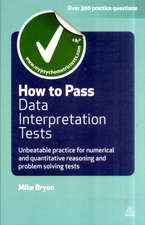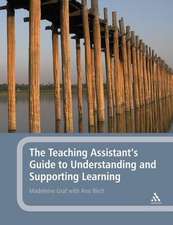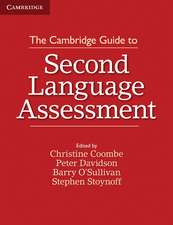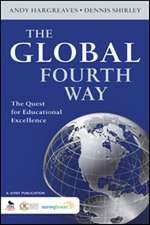The Principal as Early Literacy Leader: Leading Student Achievement Series
Autor Ontario Principals' Councilen Limba Engleză Paperback – 3 feb 2009
Preț: 229.39 lei
Nou
Puncte Express: 344
Preț estimativ în valută:
43.89€ • 47.83$ • 36.99£
43.89€ • 47.83$ • 36.99£
Carte tipărită la comandă
Livrare economică 23 aprilie-07 mai
Preluare comenzi: 021 569.72.76
Specificații
ISBN-13: 9781412963077
ISBN-10: 1412963079
Pagini: 160
Dimensiuni: 152 x 229 x 15 mm
Greutate: 0.25 kg
Ediția:1
Editura: SAGE Publications
Colecția Corwin
Seria Leading Student Achievement Series
Locul publicării:Thousand Oaks, United States
ISBN-10: 1412963079
Pagini: 160
Dimensiuni: 152 x 229 x 15 mm
Greutate: 0.25 kg
Ediția:1
Editura: SAGE Publications
Colecția Corwin
Seria Leading Student Achievement Series
Locul publicării:Thousand Oaks, United States
Recenzii
“This series of publications addresses some of the most important improvement challenges facing school leaders today. The authors of the series bring a remarkable combination of deep, practical experience and academic sophistication to these challenges. The series should be required reading for all school leaders.”
“At last, a series of outstanding books by practicing administrators, for practicing principals. Avoiding high-flown theory on the one hand and mere lists of bullet points on the other, these books represent the best that highly expert leaders have to offer—intellectually informed ideas about how to deal with the compelling practical issues of principalship. Getting down from the ivory tower and stepping out of the principal’s office, these authors offer some of the most important and useful books about leadership that principals can buy.”
“This series of little volumes offers a plethora of rich ideas ranging from practice and specific methods right down to easy-to-use worksheets. It provides a valuable resource for new principals who would become accomplished instructional leaders and also for seasoned principals looking to strengthen their leadership capacity.”
“This is a great series that allows school principals to integrate theory and practice themselves, resulting in highly insightful and practical strategies that will make a difference in schools. Practitioners: lead thyselves!”
“At last, a series of outstanding books by practicing administrators, for practicing principals. Avoiding high-flown theory on the one hand and mere lists of bullet points on the other, these books represent the best that highly expert leaders have to offer—intellectually informed ideas about how to deal with the compelling practical issues of principalship. Getting down from the ivory tower and stepping out of the principal’s office, these authors offer some of the most important and useful books about leadership that principals can buy.”
“This series of little volumes offers a plethora of rich ideas ranging from practice and specific methods right down to easy-to-use worksheets. It provides a valuable resource for new principals who would become accomplished instructional leaders and also for seasoned principals looking to strengthen their leadership capacity.”
“This is a great series that allows school principals to integrate theory and practice themselves, resulting in highly insightful and practical strategies that will make a difference in schools. Practitioners: lead thyselves!”
Cuprins
Acknowledgments
Introduction
1. What Every School Leader Needs to Know About How Young Children Learn Differently
Young Children Learn…Differently
Play: A Window Into Children's Learning
Young Children Learning Language Through Social Interaction and Intellectual Play
Language: The Early Framework for Later Thinking
The Intellectual Behavior of Young Children
Early Literacy: It's More Than Sounds and Letters
2. What We Know Makes the Difference
Transforming the Culture: The Role of the School Leader
Assessing Program: One Size Does Not Fit All
Recognizing Teacher Perception: Think They Will or Think They Won't, You're Right!
Developing the Early Dispositions to Be Readers, Writers, and Critical Thinkers
Creating the Conditions for Literacy: Six Ts for Exemplary Teaching
Developing an Inclusive Literate Community: Providing One-on-one Support Through Multi-Age Buddies
Strategizing for a More Flexible Curriculum
Defining the Teacher's Role
Developing Literate-Rich Environments at School
Building Partnerships With Parents
Early Identification Processes
3. Instructional Leadership: The Tools You Will Need
Developing a Vision: Changing Cultures
Guiding Principles
Defining Literacy: Three Key Expectations
Assessing Learning: What Counts as Evidence?
Management by Walking Around and What to Look For
Planning Models
Re-Conceptualizing Traditional Unit Plans
Timetables
Communication With Parents
4. Continuous Improvement: The Next Steps
Creating Professional Learning Conversations
Setting SMART Goals
Evidence-Based Decision Making
Teacher's Professional Development
Conclusion
Glossary
Tools for School Leaders
Must Reads
References
Index
Introduction
1. What Every School Leader Needs to Know About How Young Children Learn Differently
Young Children Learn…Differently
Play: A Window Into Children's Learning
Young Children Learning Language Through Social Interaction and Intellectual Play
Language: The Early Framework for Later Thinking
The Intellectual Behavior of Young Children
Early Literacy: It's More Than Sounds and Letters
2. What We Know Makes the Difference
Transforming the Culture: The Role of the School Leader
Assessing Program: One Size Does Not Fit All
Recognizing Teacher Perception: Think They Will or Think They Won't, You're Right!
Developing the Early Dispositions to Be Readers, Writers, and Critical Thinkers
Creating the Conditions for Literacy: Six Ts for Exemplary Teaching
Developing an Inclusive Literate Community: Providing One-on-one Support Through Multi-Age Buddies
Strategizing for a More Flexible Curriculum
Defining the Teacher's Role
Developing Literate-Rich Environments at School
Building Partnerships With Parents
Early Identification Processes
3. Instructional Leadership: The Tools You Will Need
Developing a Vision: Changing Cultures
Guiding Principles
Defining Literacy: Three Key Expectations
Assessing Learning: What Counts as Evidence?
Management by Walking Around and What to Look For
Planning Models
Re-Conceptualizing Traditional Unit Plans
Timetables
Communication With Parents
4. Continuous Improvement: The Next Steps
Creating Professional Learning Conversations
Setting SMART Goals
Evidence-Based Decision Making
Teacher's Professional Development
Conclusion
Glossary
Tools for School Leaders
Must Reads
References
Index
Descriere
This resource presents an overview of how three-, four-, and five-year-olds learn to read and shows school leaders how to implement and support quality early literacy programs.

















